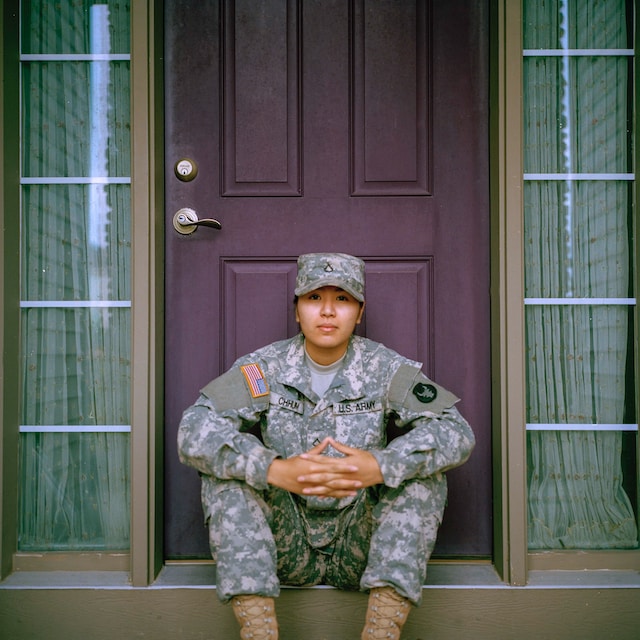
Our U.S. armed forces have been man powered by an all-volunteer population since the early 1970’s. In order to continue the over 2-million-person force and operate the entire military operations the Department of Defense has a robust recruitment system that has a huge presence in public high schools. The current targeted age of military recruitment is the 17-24 year old which makes recruiting for the military just as common as recruiting for college1. However, choosing to join the armed forces is a very different commitment than selecting a place of higher education. An ethical discussion between parents about the contact and communication between military recruiters and high school students inspired this article. Some parents may see their high school student as still an impressionable child that could easily be persuaded not fully understanding the commitment of enlisting. For many parents of this generation, military can be associated with war. As a parent that grew up in the 90’s, my experience with the military included having uncles that served in the Vietnam War and Desert Storm. Then later I almost joined the military just months before the attack on 9/11 that lead to the Iraq war which lasted for almost a decade. A person’s decision to join is ultimately their own, but the question remains whether young people between the ages of 17-24 years of age are well informed and able to make sound decisions right after high school.
All Volunteer System
When communicating with today’s youth, we can consider the history of the all-volunteer force, as well as how we can extend this practice while adhering to ethics and laws. Since 1636, the United States of America has had some type of national defense with the first major branch, the U.S. Army, beginning in 17752. The Civil War prompted riots in New York and other cities when Abraham Lincoln introduced the draft. Much later the Vietnam draft was the driving force for the end of the draft because many Americans became objectors of the draft system. The draft system ended not only because of its unpopularity after the deadly Vietnam war but it was found that an all volunteer force could be more effective. Morale is affected by whether a service member volunteers versus being drafted. When an individual decides to join the military, it is most likely with the motivation of the benefits of service such as job training, medical and education benefits they can receive while active duty or after their time of service3

Photo by Sheila Sund
The Laws that Govern Communication
The Every Students Succeeds Act (ESSA) law formally known as the No Child left behind Act requires all schools that receive government funding to provide military recruiters directory information about their students just as they would to colleges for recruitment purposes. If a school doesn’t comply with this requirement they stand to lose federal funds. The information they are obligated to provide includes names, addresses, phone number and email addresses. Many parents will come across a recruitment text if they provided their phone number as a part of their child’s legal record. Most school districts will have a waiver option to have parent opt-out of military recruiting communications. My local school system provides this option in the registration paperwork which includes the Family Educational Rights and Privacy Act (FERPA)4 However, if a high school student or their parent received recruitment materials this practice is not only legal but also one of the main pipeline options for military recruitment. In 2005, a group of anti-war organizations banned together for a nationwide initiative called “Leave My Child Alone” coalition to encourage parents to opt out of military recruitment information release5 A parents hesitation is understandable when their perspective focuses on protecting their child from harm however the military pathway is not always straight path into a warzone.
In an interview with Deputy Commander, Hany Noureddine of the US Army 5th Recruiting Brigade, he explained that the recruiting process very much involves families especially if the recruit is in high school. The recruiting piece in schools is to peak interest and show students what the military service has to offer and whether it would be a good fit for the individual. It was explained as a very similar process as how a college would recruit a high school senior. The military recruiters offer tailored literature that provides information about education benefits, military occupational specialties, ROTC, Reserves, loan repayment program, and after service opportunities. When I asked about parental engagement, Deputy Commander Noureddine explained that this is usually a family decision especially if a student is still a minor. Minors cannot enlist without parental consent but the goal of the military is not to solicit minors since most high school seniors are either 18 years or will be that age shortly after graduation. During the interview, the question of how recruiters are trained to speak to high school students was discussed. It was explained that the Army recruiters have a mandatory six month course that trains them on how to conduct an interview, assess goals of the prospect and how to explained the background of the service and processes required. In other words, the military doesn’t just send just anyone to recruit these students, they are trained and there is policy and procedure involved.6
Ways of Communication

U.S. Army recruiting at Clarksburg High School in Maryland. March 2022.
It’s 12:30 p.m. on a regular school day in America. The lunch line is long, the voices carry over each other and the center atrium is packed with students enjoying their break from class. On one side are the lockers and some banners hanging right by the U.S. and state flags. Underneath that is a table with pamphlets of information and a pop up banner that reads, “Be All You Can Be”. A young soldier in his military uniform approaches a small group of students. “What’s your plan for after you graduate?” The group is shy but entertain him and one says, “ I don’t know maybe college or hey maybe go join you!”.
It is quite common to see a military recruitment table in the lunchroom or common areas in many high schools in America. Military recruiters also give presentations to large groups along with providing marketing materials to promote enlistment. The simple “I Want You” print poster campaign used during World War I has moved to text messaging and social media recruiting. The military career path and the recruiting process has changed drastically over the years. The different branches of the military service have mottos or slogans that focus on core values to draw in their enlistees. “If the military seeks recruits motivated by needs for self-actualization, esteem, and autonomy, then slogans that embody those qualities are likely to appeal to a large audience.”7 The desire to be a part of something bigger than you or a group with the same goal is always a great motivator and one that the military exploits. The question sometimes is if that loyalty and drive to be a part of the service is for country or for self. This is why recruiters not only push the brotherhood of the service but also what the service can do for you in the long term.
With the need to continue to grow and retain soldiers there is also a need to adapt to the targeted audience8 The Air Force showcased a 70-foot trailer with touch screen games and fighter jet simulators at a San Antonio Car and Comic convention with the goal of enticing the next generation of air force recruits. They also collect contact and demographic information for those that stop to participate in the entertainment they are providing. Major Gen. Edward Thomas Jr. states, “If we’re looking at the average recruiting population of 17 to 24, we have got to be where they are in those virtual spaces”.9

Benefits of Enlistment
Have you ever heard the saying “College isn’t for everyone”, well it can be true in many cases. The college pathway while the most traditional and accepted is not always the only path to a successful career. There are many skilled jobs in the military depending on what branch you decide to join. The military is getting better at aligning interests and individual goals with what branch and job the individual ends up in. For instance, if you are interested in cybersecurity you may want to join the Air Force. The Air Force provides the opportunity to be exposed to and the building of transferable skills to either work in global cybersecurity or leave the service applying training to become a cyber security expert.10 One of my childhood dreams was to be a part of the Navy JAG like characters in the movie, “A Few Good Men”. When the Army recruiter approached me at the age of 17, I asked him about the Navy. Although I wanted to become an attorney, my own family history taught me that military service would be the quickest route to achieving that goal. As a young Latina woman, I also knew the military was a very diverse organization that would give me more of an opportunity to move through the ranks if I worked hard enough.
My dream of joining the military ended when I needed parental consent and my father was nowhere to be found. When I turned eighteen, I was planning on going back to the recruitment process, but instead I chose college. In retrospect, I realize that my friends who joined when I was considering it are almost retired after twenty years of service. They will retire with the best health care benefits and educational benefits to move on to other careers. The military will pay for their Bachelors, Masters or even a law degree. If they needed a home loan, they received the best interest rates. However, if I ask any of them what they paid for to receive those benefits they would all universally say they paid a whole lot for those benefits. Joining the service as a young person means committing all your time with little say in how you spend it. You’ll most likely be away from friends and family and possibly work in places that could be dangerous. I had many friends pay with their physical and mental health. If we considered and made those choices to join at a very impressionable age that doesn’t mean it was a poor choice. What it means is that the U.S military has much responsibility to be transparent and responsible when recruiting young people. The messages they send must fall within the legal guidelines and should focus on the goals of the individual, the benefits received as well as the risks they will encounter to help today’s youth make an educated decision to join.
- Lynne Delucia. “Public High Schools Are At The Forefront For Military Recruiters”. C-HIT. August 20, 2018 Monday. https://advance-lexis-com.blume.stmarytx.edu/api/document?collection=news&id=urn:contentItem:5T2Y-2H21-JCMN-Y0VT-00000-00&context=1516831. ↵
- Comstock, Nancy W. 2023. “U.S. Armed Forces.” Salem Press Encyclopedia, January. https://discovery.ebsco.com/linkprocessor/plink?id=9ec8fe9a-7600-36da-bd4f-13be73046164. ↵
- “All-Volunteer Force | Military Force | Britannica.” Accessed February 14, 2023. https://www.britannica.com/topic/all-volunteer-force. ↵
- 2021-2022 parent student handbook – SAISD. (n.d.). Retrieved March 15, 2023, from https://www.saisd.net/upload/page/0916/Parent%20Student%20Handbook%20Draft%202021-2022.pdf. ↵
- Tannock, Stuart. “Is ‘Opting Out’ Really an Answer? Schools, Militarism, and the Counter-Recruitment Movement in Post-September 11 United States at War.” Social Justice 32, no. 3 (101) (2005): 163–78. http://www.jstor.org/stable/29768329. ↵
- Noureddine, Hany. Questions on Policy and Procedure for Military Recruiting. Email, March 20, 2023. ↵
- Miller, Sylvia A., M. Suzanne Clinton, and John P. Camey. “The Relationship of Motivators, Needs, and Involvement Factors to Preferences for Military Recruitment Slogans.” Journal of Advertising Research 47, no. 1 (March 1, 2007): 66–78. doi:10.2501/S0021849907070079. ↵
- Chretien, Todd. “No Military Recruiters in Public Schools, Scholarships for Education and Job Training.” In Government, Politics, and Protest: Essential Primary Sources, edited by K. Lee Lerner, Brenda Wilmoth Lerner, and Adrienne Wilmoth Lerner, 160–63. Detroit, MI: Gale, 2006. ↵
- U.S. Military Focuses Recruiting Efforts on Video-Game Playing Teenagers, 2022. https://www.youtube.com/watch?v=AlKvAYfZwKg. ↵
- Brianna, Mcilraith. “From the Airforce to Cybersecurity,” October 29, 2022. https://discovery-ebsco-com.blume.stmarytx.edu/linkprocessor/plink?id=a2049fc8-ec1a-3316-8f64-eae6d2e8672f. ↵




41 comments
LEE
Honestly, it was impressive after reading this article. If teens in states join the ARMY, they will deploy somewhere else in foreign countries or states. They go through lots of tough moments. So they have to think more carefully. It seems harsh that recruiters go visit high school and find someone to join the army who’s age is under 20. I joined the US army when age of 20 and it wasn’t pleasant for that young age. So people might have to think about it once more. They could possibly go when they grow up.
Lauren Sahadi
Great article. It was crazy to see how when recruiting people are going after low income or minorities. I was shocked. Recruiters are stereotyping them and making it seem like the only thing they can do to be successful is serve. The was you presented your information was very good and made me feel something when reading it. Really great job.
Daniel Gutierrez
Congrats, The poverty draft and the recruitment of young people is often overlooked and not talked about. The idea that a group of people are being pulled at high numbers in society has not been looked at enough. This article shines a light to research that does investigate this matter and I find that it refreshes my perspective and gives me new tools to have better conversations on such matters of the military and the draft
Xavier Bohorquez
I love the information and the personal anecdote you left in the middle of the article. Showing that this topic has a severity in young teenagers shows how we should make a different approach in this field. From someone who was considering joining the military and reading what you wrote, shows that I’m not alone when it comes to considering my mental health and personal well-being first over benefits. Glad this won an award!
Sudura Zakir
I was immediately attracted when I noticed the article’s title. According to my observations, military recruiters frequently visit high schools to find potential recruits. Considering that some of my old classmates are now members, I can’t help but to reflect on their courageous acts. Despite the popular belief that serving Armed Forces is a wonderful thing, when I observed some of my peers enlisting, I began to wonder whether it was moral to recruit high school students. Such as that you pointed out that the kind of dedication in the military as well as college are different. I believe the justification of free choice in both of those cases disproves any negative outcomes that might result from a young person joining the military.
Sebastian Hernandez-Soihit
Comprehensive overview of the issues surrounding the recruitment of minors into the military and raises important questions about the ethical implications of this practice. Insightful analysis and presents a balanced view of the topic, considering both the potential benefits and risks involved. A very valuable contribution to an ongoing debate!
Sebastian Hernandez-Soihit
well-researched and thought-provoking piece. comprehensive overview of the issues surrounding the recruitment of minors into the military and raises important questions about the ethical implications of this practice. Insightful analysis and presents a balanced view of the topic, considering both the potential benefits and risks involved. A very valuable contribution to an ongoing debate!
Bijou Davant
This article is so interesting! As a high schooler, it was something I noticed when the recruitment tables were constantly doing all they could to get students interested. I like how the article approaches this ethical issue from both sides!
Alexis Zepeda
Hello! Congratulations on your award! In seeing the title of this article, I was automatically interested. In my experience, it is common to see military recruits to go into high schools to recruit future soldiers. Given some of my former classmates have joined, I cannot help but think of their courage and bravery. Despite the perception that joining the military is a good thing, the thought of if recruiting high schoolers is ethical has definitely crossed my mind once I saw some of my classmates signing up. I appreciate that you mentioned how the commitment between college and the military are two different kinds. I think the argument of free-will in both of those decisions undermines the bad experiences that possibly come with joining the military at such a young age! Great job on such an insightful article!
Juan Aguirre Ramirez
Congratulations on your award winning article Stevie! Your writing style and personal experiences made the topic feel intimate and engaging. It’s true that teens often lack awareness of the recruitment process, and your article shed light on the potential benefits of serving in the military while also acknowledging the risks. The effort you put into your research is evident and the importance of the topic cannot be overstated. Overall, you did a great job and the award is well-deserved!